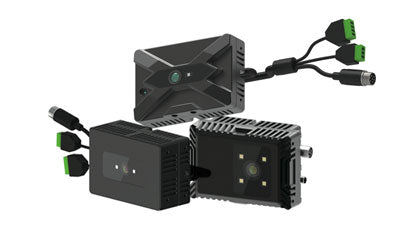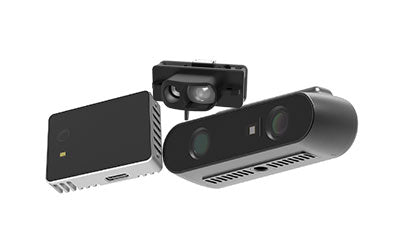TOF Tech for Intelligent Inspection in Green Energy & Solar Industry

Under the background of the 'dual carbon' policy and the global energy structure transformation, green energy sectors such as photovoltaics, wind power, and energy storage are developing rapidly, putting higher demands on intelligent inspection and automation technologies. As an emerging 3D sensing method, Time-of-Flight (TOF) technology is bringing disruptive changes to photovoltaic module inspection, intelligent manufacturing, and equipment maintenance.
What is a 3D ToF camera?
A 3D ToF camera uses the 'Time of Flight' principle to obtain 3D depth information of objects. It emits infrared light or laser pulses and measures the time it takes for the light to travel from the source, reflect off the object, and return to the sensor. By calculating the distance for each pixel, it generates a high-precision depth map. This type of camera is widely used in autonomous driving, robot navigation, facial recognition, gesture recognition, and industrial inspection, featuring advantages such as high speed, high accuracy, and strong anti-interference capability.
Intelligent Inspection and Maintenance Needs in the Photovoltaic Industry
As the photovoltaic industry enters a stage of large-scale production, high efficiency, and cost competition, intelligent manufacturing becomes key to improving capacity and yield. In the production of photovoltaic modules—from silicon wafers, solar cells to assembled modules—various defects can occur, such as microcracks, scratches, foreign object occlusion, poor welding, hidden cracks, and lamination defects. These flaws not only reduce conversion efficiency but may also cause safety risks during operation. Therefore, establishing an efficient, intelligent, and fully automated inspection and maintenance system is critical.
Traditional machine vision systems are limited by 2D imaging and struggle to accurately capture surface height variations, subtle deformations, and 3D structural abnormalities. The 3D TOF camera measures the flight time of light pulses from emission to reception, obtaining depth information for every pixel, thereby constructing high-resolution, high-precision 3D point clouds. This non-contact, high-frame-rate imaging method is particularly suitable for high-speed production lines. It can perform real-time modeling and monitoring of photovoltaic module surfaces, effectively identifying structural defects like hidden cracks, warping, and surface unevenness that are difficult to detect with 2D images.
Complementing TOF technology is the 3D Vision Inspection system, which uses deep learning algorithms and multi-dimensional data fusion to intelligently recognize and classify the acquired 3D data. This achieves fully automated defect detection, grading, and marking. Furthermore, integration with industrial robots enables automatic removal or reprocessing of defective modules, significantly improving inspection efficiency and yield while reducing manual intervention and false positives.
Such systems can also extend to the maintenance phase of photovoltaic power plants. Deployed on inspection robots or drones, TOF 3D cameras perform periodic 3D scanning of operating modules to provide early warnings of hot spots, surface contamination, structural deformation, and other faults. This enables full lifecycle intelligent monitoring and maintenance from production to application.
In summary, the introduction of 3D TOF cameras and 3D vision inspection systems is progressively driving the photovoltaic industry’s transformation from traditional inspection to intelligent, automated, and refined management. They are vital technologies for improving product quality, ensuring system safety, and optimizing operational efficiency.
The Role of TOF in Panel Defect Detection and Automated Module Assembly
In the encapsulation, sorting, and assembly stages of solar panels, TOF sensors (Time of Flight Sensors) play a crucial role. With millimeter-level 3D ranging precision, TOF sensors provide automated robotic arms with accurate spatial position and distance data, greatly enhancing their positioning, grasping, and assembly efficiency and accuracy in complex environments.
Specifically, combining TOF technology with RGBD cameras (RGB-D Cameras) allows fusion of depth and color images, enabling precise detection of incoming panels’ positions and 3D poses, as well as identification of minor deformations or defects. This multi-modal sensing capability strengthens the automated assembly line’s environmental adaptability and intelligent decision-making, allowing flexible switching between components of different specifications and conditions, significantly improving assembly line flexibility and automation.
Moreover, the deep integration of TOF technology with AGV navigation systems (Automated Guided Vehicle Navigation Methods) provides solid support for flexible transportation and intelligent handling of photovoltaic modules. AGVs use TOF sensors to obtain real-time 3D spatial information of their surroundings, achieving precise obstacle avoidance and path planning to ensure safety and efficiency during module transport. Compared to traditional laser ranging solutions, TOF sensors offer advantages such as lower cost, faster response, and non-contact, non-destructive detection. They also perform better in photovoltaic manufacturing environments, which demand high cleanliness and product integrity.
In summary, TOF technology not only enhances detection accuracy and assembly automation in key stages of solar panel manufacturing but also supports intelligent flexible manufacturing and logistics management on the production line. Its application effectively reduces risks and costs associated with manual operations, improves production efficiency and product consistency, making it a core technology driving the photovoltaic industry’s smart manufacturing transformation.
Collaborative Optimization of Production Efficiency with Vision Systems
In modern intelligent manufacturing environments, the deep integration of TOF (Time of Flight) technology with 3D machine vision and visual SLAM (Simultaneous Localization and Mapping) technologies is driving a qualitative leap in production line efficiency. This integration builds an intelligent manufacturing closed loop of 'perception + decision-making + execution,' significantly enhancing automation and responsiveness.
By introducing advanced SLAM robot navigation systems, TOF and vision sensing technologies work collaboratively to achieve precise multi-device localization and synchronous cooperation. Robots can leverage SLAM to perform real-time environment mapping, self-localization in dynamic production environments, intelligently avoid moving obstacles, and plan optimal paths. This ensures high-efficiency, safe logistics, assembly, and quality inspection processes. The approach greatly reduces manual intervention and operational errors, while enhancing line flexibility and adaptability to diverse and customized production demands.
Additionally, TOF technology is critical in AI-based intelligent quality inspection systems (Custom Artificial Intelligence Solutions). Using high-precision depth data from TOF combined with machine learning and deep learning algorithms, more accurate and robust defect recognition models can be constructed. Unlike traditional 2D image processing, 3D data from TOF provides rich spatial depth features, making the system more sensitive and stable in detecting complex defects such as microcracks, surface unevenness, and foreign object occlusion. The system can automatically alarm, perform intelligent re-inspection, and provide real-time defect feedback, forming a complete data loop that continuously optimizes detection algorithms and production processes.
Through this multi-dimensional perception and intelligent decision-making collaboration, overall production line efficiency is significantly improved. It not only raises product pass rates and reduces rework but also shortens production cycles and lowers operating costs. Looking ahead, with ongoing hardware and algorithm upgrades in TOF and vision systems, their collaborative optimization capability in intelligent manufacturing will further advance, propelling the manufacturing industry towards higher levels of digitalization and intelligence.
Potential Application Expansion of TOF in Wind Energy and Energy Storage Fields
Beyond its extensive use in the photovoltaic industry, Time of Flight (TOF) technology also demonstrates significant development potential and application value in the manufacturing of wind energy and energy storage equipment.
In the intelligent inspection of wind power equipment, TOF technology enables comprehensive scanning and monitoring of wind turbine blades’ surfaces through high-precision 3D imaging. Leveraging the depth information captured by 3D TOF Cameras, it can detect cracks, wear, corrosion, and other subtle structural damages on the blades at an early stage, allowing timely alerts and maintenance scheduling.
This significantly improves the operational safety and stability of wind turbines, extends equipment lifespan, and reduces operation and maintenance costs. Particularly in the complex outdoor environments of wind farms, TOF’s non-contact and high-speed response advantages make it an indispensable inspection tool that traditional 2D vision systems struggle to replace.
In the energy storage system module inspection, TOF technology assists robots in precisely locating and accurately assembling battery modules, avoiding damage caused by misoperations. By real-time acquisition of the battery module’s 3D shape and spatial position, TOF technology effectively enhances the automation level and assembly quality of energy storage production lines. Additionally, TOF can detect deformation and swelling of battery casings, helping to identify battery anomalies and ensure the safe operation of energy storage systems. Its fast and non-destructive detection characteristics meet the stringent requirements of product safety and reliability in the energy storage industry.
With continuous upgrades in 3D TOF Camera technology, TOF sensors exhibit stronger expansion capabilities in key areas such as robot vision systems and intelligent warehouse AGV (Automated Guided Vehicle) handling. Using high-precision 3D environmental data provided by TOF, robots achieve more accurate path planning and obstacle avoidance, improving operational efficiency and flexibility in complex environments. Intelligent warehouse systems utilize TOF technology for efficient material recognition and handling, promoting full-process intelligent transformation from production to logistics in the green energy industry chain.
In summary, TOF technology is continuously expanding its application boundaries in the wind energy and energy storage fields, becoming a critical technological support for promoting intelligent and digital development of green energy equipment and contributing significantly to achieving efficient, safe, and sustainable energy industry development.
Deep Integration Trends of Intelligent Manufacturing and Green Energy
Currently, the global green energy industry is accelerating into a new development stage driven by the dual engines of “intelligence + green low carbon.” Against this backdrop, the deep integration of intelligent manufacturing technologies and the green energy industry has become a core driving force for high-quality industry development. Especially represented by advanced three-dimensional imaging and sensing technologies such as TOF 3D Sensing (Time-of-Flight 3D sensing technology), these technologies show tremendous application potential and industrial value across various green energy subfields like photovoltaics, wind energy, and energy storage.
In the intelligent inspection of photovoltaic module production, TOF technology accurately captures micro-cracks, scratches, foreign object occlusions, and other defects on silicon wafers, solar cells, and modules. It realizes efficient, non-contact 3D quality inspection, greatly improving detection efficiency and accuracy and driving photovoltaic manufacturing toward automation and intelligence.
Meanwhile, automated maintenance of wind power equipment relies on TOF’s high-precision 3D data acquisition to monitor the real-time status of key parts such as turbine blades and enable early fault diagnosis, ensuring safe and stable wind power facility operation and reducing maintenance costs. Similarly, in precise identification of energy storage battery assembly, TOF combined with robotic vision technology enables accurate positioning and flexible assembly of battery modules, effectively preventing damage and assembly errors while enhancing the safety and reliability of energy storage systems.
Looking ahead, with continuous breakthroughs in 3D SLAM (Simultaneous Localization and Mapping) technology, DTOF (Digital Time-of-Flight) technology, and RGB-D perception systems, TOF’s 3D sensing capabilities will become more refined, intelligent, and diversified. These technologies not only make industrial inspection and equipment maintenance smarter and more efficient but also promote automation and digital upgrades of green energy production environments, enabling adaptive device adjustments, dynamic environment perception, and intelligent decision support.
Moreover, TOF technology demonstrates unique advantages in reducing system energy consumption and optimizing resource allocation. By real-time and precise monitoring of environment and equipment status, it effectively prevents energy waste and excessive maintenance, assisting the green energy industry in achieving genuine green and low-carbon goals. Additionally, TOF’s rapid response and low power consumption characteristics suit various complex working conditions and diverse application scenarios, becoming an essential technology engine for intelligent manufacturing’s green transformation.
In conclusion, the trend of deep integration between intelligent manufacturing and green energy is becoming increasingly evident. As one of the core driving forces, TOF 3D sensing technology will continuously promote the intelligent upgrading of industrial chains and green sustainable development, helping to build a future clean, efficient, and intelligent energy ecosystem.
Conclusion:
From photovoltaics to wind energy, from manufacturing to maintenance, TOF technology is deeply embedded in every link of the green energy industry. With the aid of TOF cameras, 3D depth sensing, and AI collaborative systems, enterprises are steadily advancing toward efficient, intelligent, and green manufacturing goals. For companies dedicated to intelligent manufacturing solutions integrated with green energy, TOF undoubtedly serves as an indispensable strategic technology pillar.
Synexens Industrial Outdoor 4m TOF Sensor Depth 3D Camera Rangefinder_CS40p
After-sales Support:
Our professional technical team specializing in 3D camera ranging is ready to assist you at any time. Whether you encounter any issues with your TOF camera after purchase or need clarification on TOF technology, feel free to contact us anytime. We are committed to providing high-quality technical after-sales service and user experience, ensuring your peace of mind in both shopping and using our products.






